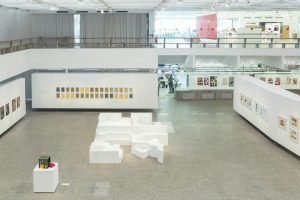The return of Lina Bo Bardi’s radical crystal easels to the display of the collection presents a selection of 119 artworks drawn from the museum’s diverse holdings, spanning from the 4th century BC to 2008. The easels were first presented at the opening of the museum’s current venue in 1968, and withdrawn in 1996.
The return of the easels is not a fetishistic or nostalgic gesture in regard to what has become an iconic exhibition display device, but should rather be understood as part of a programmatic revision of Bo Bardi’s spatial and conceptual contributions to museum practice.
The political dimension of her proposals is suggested by the open, transparent, fluid, and permeable picture gallery, which offers multiple possibilities for access and reading, eliminates hierarchies and predetermined paths, and challenges canonical art-historical narratives. The gesture of taking the paintings off the wall and placing them on the easels implies their desacralization, rendering them more familiar to the public.
Moreover, the placement of the labels on their backs allows for an initial direct encounter with the work, free from an interpretive framework. In this context, the museum experience becomes more human, plural, and democratic
In the original configuration of the easels, Lina Bo Bardi and Pietro Maria Bardi organized the works by artistic schools or regions. Now they will be placed in strict chronological order, laid out in a meandering path. This organization does not coincide with the chronology of art history, with its schools and movements, nor does it oblige the public to follow its course.
The spatial transparency of the open floor plan and the easels invites visitors to construct their own path, enabling unexpected juxtapositions and dialogues between Asian, African, Brazilian, and European art.
Furthermore, Picture Gallery in Transformation is a semi-permanente collection display, as it will remain open to frequent changes, adjustments and modifications, already planned for early 2016. In this sense, the exhibition avoids the typical ossification and sedimentation of permanent collection displays.
The exhibition’s focus on figurative art reflects the history of the collection and the interests of Bo Bardi and Bardi, who resisted the hegemony of the abstract tradition in Brazil in the 1940s and 1950s. They were both wary of abstraction’s potentially depoliticizing effects, in the context of the promotion of geometric abstraction by the US through its Good Neighbor policy during the Cold War.
The current display also includes works by artists traditionally considered outside of the Brazilian art-historical canon – such as Agostinho Batista de Freitas, Djanira, João António da Silva, and Maria Auxiliadora“ highlighting MASP’s commitment to diversity and multiplicity.
Sao Paulo Art Museum
The Museu de Arte de São Paulo (MASP) is a private not-for-profit museum founded in 1947 by business mogul and patron of the arts Assis Chateaubriand (1892–1968), becoming the first modern museum in the country. Chateaubriand invited Italian art dealer and critic Pietro Maria Bardi (1900–1999) to direct MASP, and Lina Bo Bardi (1914–1992) to conceive the architecture and the exhibition design. With the most important collection of European art in the southern hemisphere, MASP’s holdings currently consist of more than 11 thousand artworks, including paintings, sculptures, objects, photographs, videos and pieces of clothing from various periods, from Europe, Africa, Asia and the Americas.
Initially located on the street 7 de Abril, in downtown São Paulo, in 1968 the museum was transferred to its current location on Avenida Paulista, in the iconic building designed by Lina Bo Bardi, which has become a landmark in the history of 20th-century architecture. Making use of glass and concrete, in her architecture Lina Bo Bardi put rough, unfinished surfaces into harmony with aspects of lightness, transparency and suspension. The ground-level plaza under the building’s immense free span was designed as a multipurpose public square.
The architect’s radicality is also present in the glass display easels created to show the collection on the building’s second floor. By taking the artworks off the walls, the display easels question the traditional model of the European museum, in which the spectator is led to follow a linear narrative suggested by the order and arrangement of the artworks in the rooms. In MASP’s spacious picture gallery, the suspended and transparent exhibition design allows the public to engage in a closer relationship with the collection since the visitor can choose his or her own path among the artworks, move around them and see their backs.
Besides the long-term show Acervo em transformação [Collection in Transformation] in the museum’s picture gallery, throughout each year there is a broad programming of group exhibitions and solo shows articulated around thematic axes: histories of sexuality (2017), Afro-Atlantic histories (2018), histories of feminism/women (2019). It is important to consider the plural quality of the term “histories,” pointing to multiple, diverse and polyphonic histories, open, inconstant and unfinished histories, fragmented and layered histories, nontotalizing and nondefinitive histories. In Portuguese, the word histórias can denote either fictional stories or factual histories, narratives that can be personal and political, private and public, micro and macro.
This approach reflects the museum’s new mission, established in 2017: “MASP, a diverse, inclusive and plural museum, has the mission to establish, in a critical and creative way, dialogues between past and present, cultures and territories, through the visual arts. To this end, it should enlarge, conserve, research and disseminate its collection, while also promoting the encounter between its various publics and art through transformative and welcoming experiences.”
The calendar of exhibitions is complemented by the public programs developed by the museum’s mediation team and includes international seminars, lectures held on the first Saturday of each month, the MASP teachers program, workshops, courses in the MASP school, and a program of films and videos. To enlarge and perpetuate the discussion around all this programming, the museum produces a series of publications including catalogs of exhibitions and collections, anthologies of the seminars and lectures, as well as materials focused on special projects such as artwork restorations.


